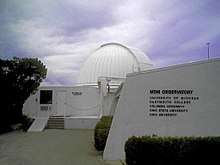MDM Observatory
The MDM Observatory (Michigan-Dartmouth-MIT Observatory; obs. code: 697) is an optical astronomical observatory located adjacent to Kitt Peak National Observatory on Kitt Peak, west of Tucson, Arizona, in the United States. It is owned and operated by the University of Michigan, Dartmouth College, Ohio State University, Columbia University, and Ohio University. The Massachusetts Institute of Technology (MIT) was also part of the operating consortium in the past.
 MDM Hiltner 2.4 m Telescope | |
| Organization | Columbia University Dartmouth College Ohio State University Ohio University University of Michigan |
|---|---|
| Observatory code | 697 |
| Location | Kitt Peak, Arizona, US |
| Coordinates | 31°57′06″N 111°36′58″W |
| Telescopes | Hiltner 2.4m Telescope McGraw-Hill Telescope |
 Location of MDM Observatory | |
It has two reflecting telescopes, the 2.4-meter (95 inches aperture Hiltner Telescope (since 1986), used for galactic surveys, and the 1.3-meter (50 inch diameter aperture) McGraw–Hill Telescope (since 1975), which was originally located near Ann Arbor, Michigan.[1]
Hiltner Telescope
The mirror of the 2.4-meter Hiltner Telescope is aluminum-coated Cer-Vit, and usable foci include f/7.5 and f/13.5 Cassegrain foci.[2] The telescope was built in 1986 and the mirrors were re-polished in 1991.[3] It was named after astronomer W. Albert Hiltner (1914-1991).[4]
The Hiltner was one of the telescopes that observed the turn on a nuclear transit, along with the Swift space telescope (aka Neil Gehrels Swift Observatory since 2018) and the Gemini observatory (8 meter ground observatory).[5] The transient event was called PS1-13cbe and was located in the Galaxy SDSS J222153.87+003054.2.[5]
McGraw–Hill Telescope

The 1.3-meter McGraw-Hill Telescope, with a 1.27-meter clear aperture, is an aluminum-coated Cer-Vit (low thermal expansion glass) telescope. Its usable foci include f/7.5 and f/13.5.[6] The telescope was originally installed at Stinchfield Woods, Michigan in 1969, and moved in 1975 to MDM.[1]
Asteroid 4432 McGraw-Hill
The asteroid 4432 McGraw-Hill is named after this telescope. It was discovered on March 2, 1981 by Schelte J. Bus at Siding Spring in the course of the UK Schmidt-Caltech Asteroid Survey. On February 18, 1992, the International Astronomical Union officially assigned the name "McGraw-Hill" to the asteroid. The text of the citation, as officially published by IAU Commission 20 (M.P.C. 19697),[7] is as follows:[8]
Named after the 1.3 m McGraw-Hill telescope located on the southwestern ridge of Kitt Peak, Arizona, which was the site for the first physical observations for this minor planet. The telescope is operated by a consortium comprising the University of Michigan, Dartmouth College, and the Massachusetts Institute of Technology. Originally erected at Stinchfield Woods near Dexter, Michigan, in July 1969, the telescope was moved to its current location in 1975 through the generous financial support of McGraw-Hill Incorporated and the Sloan Foundation. Name proposed and citation provided by Richard P. Binzel.
Gallery
 View from the Point
View from the Point View down Kitt Peak from MDM
View down Kitt Peak from MDM View up Kitt Peak from MDM
View up Kitt Peak from MDM Opening the Dome
Opening the Dome Instruments
Instruments Instruments
Instruments
References
- MH Telescope Specifications
- "Archived copy". Archived from the original on 2010-06-07. Retrieved 2010-11-14.CS1 maint: archived copy as title (link)
- "Archived copy". Archived from the original on 2011-07-16. Retrieved 2010-11-14.CS1 maint: archived copy as title (link)
- "Archived copy". Archived from the original on 2010-06-07. Retrieved 2010-03-14.CS1 maint: archived copy as title (link)
- "Rapid 'turn-on' of a nuclear transient observed by astronomers". phys.org. Retrieved 2019-10-14.
- "Archived copy". Archived from the original on 2012-03-12. Retrieved 2012-03-05.CS1 maint: archived copy as title (link)
- "MPC/MPO/MPS Archive". Minor Planet Center. Retrieved 27 May 2018.
- "4432 McGraw-Hill (1981 ER22)". Minor Planet Center. Retrieved 27 May 2018.
External links
- MDM Observatory
- Aerial view of observatory
- Kitt Peak Clear Sky Clock Forecasts of observing conditions.